

Sous Vide Kits. FreshMealsMagic (FMM) is the world’s first submersion heater with integrated air circulator ( bubbler) developed specifically for professional sous vide cooking.
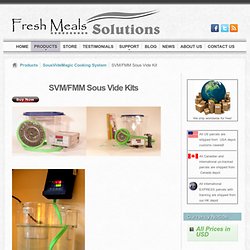
The stability and accuracy is within 0.1C from 50C to 75C. For ordering all the different componnents, we have pre-packaged several kits for your covenience and budget. Some kits are geared for the North American market, so international customers do take care when ordering. 12-month warranty. Sous Vide Cooking Technique - PolyScience - Sous Vide.
Cooking Sous Vide the DIY Way. Everyone's talking about sous vide, the scientific cooking method that's making its way from the lab to the home kitchen.
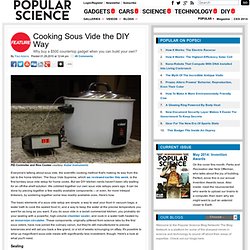
The Sous Vide Supreme, which we reviewed earlier this week, is the first turnkey sous vide setup for home cooks. But we DIY kitchen nerds haven't been idly waiting for an off-the-shelf solution: We cobbled together our own sous vide setups years ago. It can be done by piecing together a few readily available components -- or even, for more intrepid tinkerers, by soldering together some less readily available ones. Here's how. The basic elements of a sous vide setup are simple: a way to seal your food in vacuum bags; a water bath to cook the sealed food in; and a way to keep the water at the precise temperature you want for as long as you want.
Sealing. Sous-Vide 101: Prime Steak Primer. Clockwise from top: Steaks cooked to various temperatures, a perfect hanger steak, chart of moisture loss.
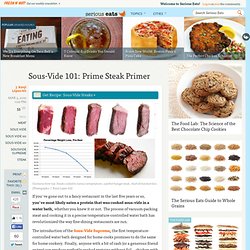
[Photographs: J. Kenji Lopez-Alt] If you've gone out to a fancy restaurant in the last five years or so, you've most likely eaten a protein that was cooked sous-vide in a water bath, whether you knew it or not. The process of vacuum-packing meat and cooking it in a precise temperature-controlled water bath has revolutionized the way fine-dining restaurants are run.
The introduction of the Sous-Vide Supreme, the first temperature-controlled water bath designed for home cooks promises to do the same for home cookery. Unfortunately, there aren't too many practical resources for home cooks now that they've actually got the damn machines. A good steak is a good place to start. Why would anyone want to cook a steak sous-vide, you might ask? It's simple enough that it can be accomplished with about 5 minutes of active work, and under an hour from start to finish. Temperature and Time Searing. A Practical Guide to Sous Vide Cooking. Which is right for you?

Sous Vide for the Home Cook My book, Sous Vide for the Home Cook, came out in 2010. You can now order the second eddition from Amazon.com (under “See All Buying Options.”), Amazon.co.uk (under “Available from these sellers.”), Vac-Star in Germany, and the SousVide Supreme site. My book has over 200 delicious recipes for beef, pork, lamb, game, chicken, turkey, duck, fish, shellfish, vegetables, fruits, legumes, ice cream bases, sauces, and yogurt. I first cover the basics of sous vide cooking with “learn by doing” sections; then I have a 10-page table with times and temperatures for every cut of meat or type of vegetable you’re likely to come across; this is followed by over 200 detailed recipes; and finally chapters on equipment, food safety, a select bibliography, and an index.
I hope you enjoy using my book as much as I enjoyed writing it. DIY Sous Vide Cooker with Feedback Control. Sous-vide cooking involves cooking food in sealed plastic bags inside a temperature controlled water bath.
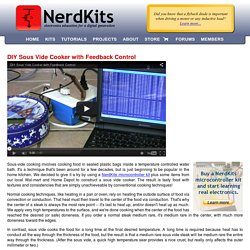
It's a technique that's been around for a few decades, but is just beginning to be popular in the home kitchen. We decided to give it a try by using a NerdKits microcontroller kit plus some items from our local Wal-mart and Home Depot to construct a sous vide cooker. The result is tasty food with textures and consistencies that are simply unachieveable by conventional cooking techniques! Normal cooking techniques, like heating in a pan or oven, rely on heating the outside surface of food via convection or conduction. That heat must then travel to the center of the food via conduction. In contrast, sous vide cooks the food for a long time at the final desired temperature. Click any photo to enlarge: Warning: There are food safety issues associated with low-temperature cooking. Warning: Some parts of this project involve working with AC line voltage. Melt butter. Sous-vide. Sous-vide (/suːˈviːd/; French for "under vacuum")[1] is a method of cooking food sealed in airtight plastic bags in a water bath or in a temperature-controlled steam environment for longer than normal cooking times—96 hours or more, in some cases—at an accurately regulated temperature much lower than normally used for cooking, typically around 55 °C (131 °F) to 60 °C (140 °F) for meats and higher for vegetables.
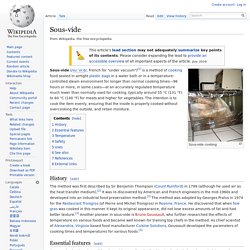
The intention is to cook the item evenly, ensuring that the inside is properly cooked without overcooking the outside, and retain moisture. History[edit] The method was first described by Sir Benjamin Thompson (Count Rumford) in 1799 (although he used air as the heat transfer medium).[2] It was re-discovered by American and French engineers in the mid-1960s and developed into an industrial food preservation method.[3] The method was adopted by Georges Pralus in 1974 for the Restaurant Troisgros (of Pierre and Michel Troisgros) in Roanne, France.
Essential features[edit] Uses[edit]